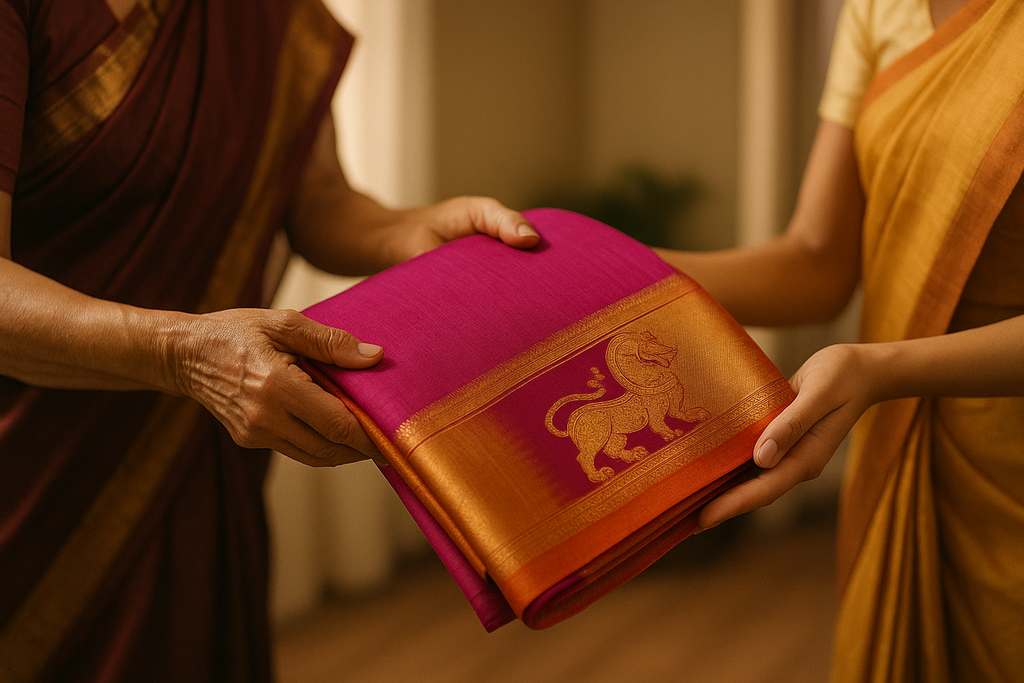Caring for Your Handwoven Sarees: Tips and Tricks

Handwoven silk sarees are more than just garments; they are treasures that embody tradition, artistry, and heritage. Each saree is a masterpiece, woven with intricate craftsmanship and often adorned with delicate zari work, making it a timeless heirloom passed down through generations. However, their beauty and elegance can fade if not cared for properly. Silk is a natural fiber that requires gentle handling to maintain its luster and strength. Without the right care, these exquisite weaves may lose their charm over time. This guide shares practical tips and tricks to help you preserve the beauty of your handwoven sarees so they remain cherished for years to come.
Why Proper Saree Care Matters
Handwoven silk sarees are delicate creations that demand special attention. The natural silk fibers are soft yet sensitive, easily losing their sheen or strength if exposed to harsh detergents, direct sunlight, or excess humidity. The intricate zari work, made with fine metallic threads, is equally vulnerable, as it can tarnish, fray, or break when mishandled. Improper storage, such as leaving sarees folded in the same position for years or keeping them in plastic covers, accelerates wear and tear. These sarees are not just clothing—they carry cultural stories and emotional memories, often becoming family heirlooms. With mindful care, you can protect their beauty, enhance their longevity, and allow their elegant drape and luster to shine for generations.
Storing Your Silk Sarees the Right Way
Proper storage plays a key role in preserving the beauty and texture of your silk sarees. These delicate weaves need breathable materials and careful handling to stay in pristine condition for years.
Choosing the Ideal Storage Materials
Always store your sarees wrapped in muslin or cotton fabric rather than plastic covers. Plastic traps moisture, which can damage the silk and cause discoloration. Wrapping them in a breathable cloth helps protect against dust, moisture, and insect damage.
Folding and Refolding Techniques
To prevent permanent creases and tearing along fold lines, refold your sarees every three to four months. Place tissue paper or a soft cotton sheet between folds to reduce friction and protect the fabric’s surface.
Avoiding Common Storage Mistakes
Store sarees in a cool, dry place, away from direct sunlight. Avoid placing mothballs directly on the fabric; instead, opt for natural repellents like neem leaves or cloves to keep pests away safely.

Cleaning and Washing Handwoven Sarees
Cleaning silk sarees requires extra care to protect their delicate fibers and vibrant colors. Using the wrong methods can lead to fading, weakening, or damage to the intricate weave.
Dry Cleaning vs. Gentle Washing
For pure silk sarees, dry cleaning is always the safest option, as professional cleaners use methods that preserve the fabric’s natural sheen and prevent color bleeding. However, softer silks or cotton-silk blends may occasionally be hand washed at home using cold water and a mild, pH-balanced detergent. Avoid wringing or twisting the fabric, and dry it in the shade to maintain its texture.
Handling Stains Safely
Accidental stains should be treated immediately with gentle care. Blot the spot with a soft cloth and mild solution, avoiding harsh scrubbing that can damage threads or zari. For stubborn stains, always consult a professional cleaner to ensure your saree remains flawless.
Preserving the Zari and Intricate Details
The zari work on handwoven sarees, often crafted from fine gold or silver threads, adds a luxurious touch but is highly prone to tarnish and wear. Exposure to sweat, perfumes, or harsh chemicals can dull its shine and weaken the threads over time. To protect zari, always drape the saree in a way that minimizes direct contact with skin products, and avoid spraying perfumes directly on the fabric. When storing, fold the saree with the zari-facing side inward to prevent friction and snagging. Placing acid-free tissue paper between folds offers an added layer of protection, keeping the threads from rubbing against each other. With these simple precautions, the intricate details of your saree will stay as stunning as the day it was woven.
Ironing and Draping Without Damage
Silk sarees require delicate handling when ironing to maintain their smooth texture and shine. Always use low heat or place a thin cotton cloth over the saree before pressing to avoid direct heat damage. A steam iron is generally safer than a traditional press, as it reduces the risk of scorching and helps smooth out wrinkles gently. Never iron directly over the zari, as high temperatures can cause it to lose its luster or break. While draping, handle the fabric with care and avoid using sharp pins that might snag or tear the weave, ensuring your saree stays flawless.
Long-Term Preservation Techniques
For long-lasting beauty, give your sarees occasional airing by unfolding and hanging them in a shaded area to prevent mildew. Store them flat whenever possible to avoid permanent fold lines, and never pack them too tightly. To protect against moisture and pests, place silica gel packets, neem leaves, or cloves in the storage area. For heirloom pieces, consider using archival-quality boxes lined with acid-free tissue to maintain their original texture and color. These practices ensure your sarees stay fresh and stunning for decades.
Professional Maintenance and Restoration
Sometimes, antique or heavily worn sarees need expert attention. Textile care professionals specialize in cleaning fragile fabrics, polishing tarnished zari, and performing delicate weaving repairs without altering the original design. Professional restoration can revive an old saree’s beauty, allowing it to be draped and admired again. Trusting experts ensures that treasured pieces retain their authenticity and continue to tell their story for generations.
Passing Down Sarees as Heirlooms
Handwoven sarees are a legacy meant to be shared. Document their origins, special occasions they were worn for, and details about their weaving to pass along their history. Share proper care instructions with the next generation so they can preserve the saree’s charm. This thoughtful practice not only keeps the fabric intact but also keeps cultural traditions and family memories alive.
Keeping the Legacy of Your Sarees Alive
Handwoven sarees deserve special care to preserve their elegance and heritage. With proper storage, gentle cleaning, and mindful handling, you can ensure they retain their beauty and significance. Treat each piece as an heirloom, and it will continue to enchant generations. Treasure your Yaalika sarees and keep their timeless allure alive for years to come.
-
Posted in
premium silk sarees




